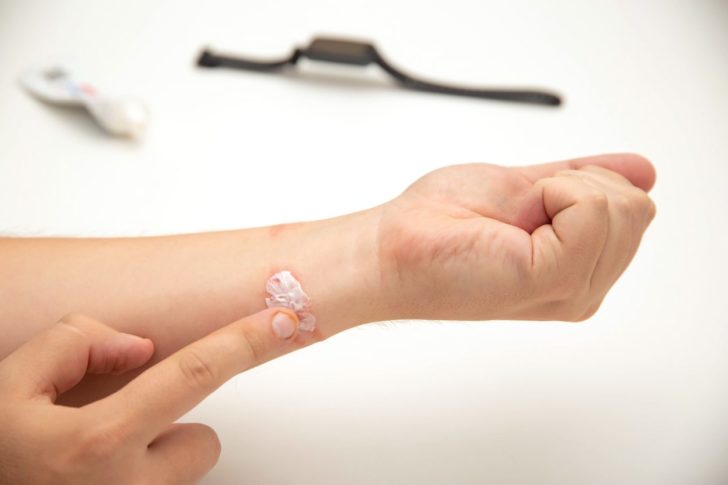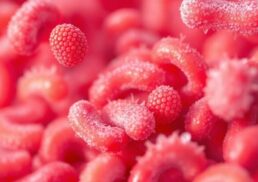Salves: an age-old remedy that has withstood the test of time. But what exactly is a salve, and how can it benefit you in today’s modern world? In this blog post, we will explore the fascinating world of salves, delving into their rich history, varied types, and multitude of uses. Prepare to embark on a journey that will uncover the secrets of these versatile healing agents and learn how they can become an indispensable part of your daily self-care routine.
Table of Contents
Key Takeaways
Salves are ointments used to treat wounds and sores, with a long history of use across many cultures.
Drawing salves should be used cautiously due to potential irritation or inflammation. Black salve poses serious risks and should be avoided.
Herbal salves offer natural healing properties for skin conditions, while DIY recipes can create personalized products for specific needs.
Understanding Salves: A Comprehensive Guide

Salves, in their essence, are medicinal ointments that have been used for centuries to heal, soothe, and protect the skin. These unctuous, adhesive substances have been a staple in various cultures throughout history, from ancient Greece to medieval Europe, demonstrating their timeless effectiveness in skincare and wound healing. The word “salve” itself is derived from the Old English word “sealf” and is related to words in Old High German, Greek, and Sanskrit, showcasing its linguistic roots and widespread influence.
While the term “salve” may seem antiquated, these healing ointments remain relevant in today’s world due to their versatile applications, ranging from drawing out splinters to soothing irritated skin. This guide will familiarize you with the definition, purpose and historical background of salves. Additionally, we’ll explore the various types of salves available to help you utilize their healing potential.
Definition and Purpose
A salve, by definition, is an ointment employed for treating wounds or sores. Its primary intent is to facilitate the healing or soothing of the skin, making it an invaluable remedy in any self-care arsenal. The word “salve” has a dual functionality, serving as both a noun and a salve verb. In its verb form, “to salve” means “to apply salve to (a wound, sore, etc.)” and “to soothe, comfort, or appease”. This duality highlights the central role that salves play in the healing process, both literally and figuratively.
Salves have proven their relief-providing and healing-promoting properties throughout history. From the enslaved Africans of the 17th and 18th centuries to the ancient Native Americans who used plant-based salves as medicinal ointment, these ointments have transcended cultural barriers and proven their worth time and time again.
Let’s discuss the different types of salves that exist today and how they vary.
Historical Background
The word “salve” can be traced back to the Old English word “sealf,” with connections to the Old High German word “salba” and even the modern German word “Salbe”. Old High German salba, as a historical term, highlights the long-standing tradition of salves in various cultures, including those that used old high german salba. Old English sealf, as a historical term, highlights the long-standing tradition of salves in various cultures. Salves have been an integral part of human history, with one of the earliest known salves being petroleum jelly, which was patented as Vaseline in 1872. As the world around us has evolved, so too have salves, adapting and diversifying to meet the needs of various cultures and societies.
Salves have been used for numerous purposes throughout history, treating everything from minor cuts and scrapes to more severe conditions. Enslaved Africans relied on salves to treat various ailments, while Native Americans harnessed the power of plants to create their own healing ointments. This rich history serves as a testament to the versatility and effectiveness of salves, making them a valuable addition to any modern self-care toolkit.
Types of Salves and Their Uses
Salves are available in a diverse range of formulations, each designed to cater to specific needs and concerns. Understanding the different types of salves and their respective uses is essential in determining which product will best suit your individual requirements. Some common types of salves include:
Drawing salves for removing foreign objects
Soothing herbal salves for natural healing
Antibacterial salves for preventing infection
Pain-relieving salves for reducing discomfort
Moisturizing salves for dry skin
From drawing salves to herbal salves that soothes, including the popular German Salbe, there is a salve for every purpose.
As we explore the world of salves further, let’s acknowledge their distinctive properties and applications. In the following sections, we will explore the different types of salves available, including drawing salves, black salve, and herbal salves, along with their uses and potential risks.
Drawing Salves
Drawing salves are a distinct type of salve, specifically designed to facilitate the removal of splinters, ingrown hairs, and other foreign bodies from the skin. Their unique formulation enables them to draw out these intruders, making the extraction process significantly easier and less painful. When using a drawing salve, ensure that you apply the ointment directly to the affected area and gently massage it into the skin until the unwanted object is removed.
Even though drawing salves can be highly effective, one should be mindful of the potential risks their usage can bring. Some individuals may experience skin irritation and inflammation as a result of using drawing salves, so it is imperative to use the product sparingly and follow the instructions on the packaging. As with any skincare product, caution and care should be exercised to ensure the best possible outcome.
Black Salve: Risks and Dangers
Black salve is a highly dangerous and corrosive substance that should be avoided at all costs. Containing highly reactive ingredients, black salve can cause severe damage to living tissue, either directly through chemical destruction or indirectly through the induction of inflammation. The risks associated with black salve are particularly concerning when used for serious conditions, such as skin cancer, as it can lead to delayed diagnosis and cancer progression.
The use of salves containing corrosive ingredients, like black salve, can result in permanent scarring and may even necessitate reconstructive surgery. These salves can cause damage to the top layer of skin while leaving cancerous cells in the deeper layers, potentially leading to further growth.
Awareness about the risks and dangers associated with black salve is essential and one should seek safe, effective alternatives for treating skin conditions.
For more info, visit The Dangers of Using Black Salve for Skin Cancer Treatment.
Herbal Salves
Herbal salves, on the other hand, are a safe and natural alternative to black salve, offering a variety of healing properties without the associated risks. Made from a combination of herbs and oils, herbal salves can be used to treat a wide range of skin conditions, including:
Eczema
Psoriasis
Minor cuts and scrapes
Insect bites and stings
They can even provide relief from insect bites and stings, making them a versatile and invaluable addition to any self-care routine.
Creating your own herbal salves at home allows for customization and control over the ingredients used, ensuring a personalized and effective healing ointment. By combining herbs, oils, and beeswax, you can tailor your salve to target specific concerns and achieve the desired consistency.
In the following sections, we will explore the process of creating your own DIY salve, along with tips for customizing and storing your homemade concoctions.
How to Apply Salve Properly
To ensure its effectiveness and maximize its healing potential, it’s important to apply the salve correctly. By following a few simple steps, you can ensure that your salve is applied correctly and provides the best possible results. In this section, we will outline the process of preparing the skin, applying the salve using the correct technique, and following appropriate aftercare procedures.
Whether you are using a store-bought salve or a homemade creation, the process for applying the ointment remains largely the same. In the following subsections, we will delve into the specifics of each step, providing you with a comprehensive guide to proper salve application.
Preparing the Skin
To ensure maximum effectiveness and prevent infection, follow these steps before applying any salve:
Cleanse the area with warm water and a gentle soap.
Pat the area dry with a clean towel.
If your skin is particularly dry or flaky, exfoliate the area to remove any dead skin cells.
Once your skin is clean and dry, you are ready to apply the salve. Using a clean finger or cotton swab, apply a thin layer of salve to the affected area. Allow the salve to absorb for at least 10 minutes before washing it off, ensuring that the active ingredients have time to penetrate the skin and work their magic.
Application Techniques
Numerous techniques exist for applying salve effectively, each with its distinct merits and advantages. Here are some common methods:
Gently rub your fingers over the top of the salve, then evenly spread it over the desired area on the body.
Use a cotton swab to apply the salve, allowing for more precise and controlled application.
Use a brush or spatula to apply the salve, allowing for more precise and controlled application.
Choose the method that works best for you and enjoy the benefits of using salve.
Regardless of the technique you choose, it is important to remember the purpose of massaging the salve into the skin. By massaging the ointment into the affected area, you facilitate even distribution and penetration of the salve, optimizing its efficacy and promoting faster healing. Experiment with different techniques to find the one that works best for you and your specific needs.
Aftercare and Reapplication
Upon applying your salve, follow any specific aftercare instructions provided by the product or your healthcare professional. In general, this may include:
Washing your hands with warm water and soap
Applying a bandage or gauze to the area if necessary
Monitoring the treated area for any changes or signs of infection.
Reapplying the salve as needed is crucial to ensuring its effectiveness and promoting healing. Adhere to any specific instructions for reapplication, and be sure to monitor the treated area for any signs of improvement or worsening. If you notice any adverse reactions or lack of progress, consult your healthcare professional for further guidance.
Salve vs. Cream vs. Balm: What’s the Difference?
While salves, creams, and balms may all appear similar at first glance, they each possess unique properties and uses that set them apart. Grasping the differences between these products can guide you in making informed decisions while selecting the suitable skincare product for your specific needs and concerns.
In this section, we will explore the distinctions between salves, creams, and balms in terms of consistency, active ingredients, and best uses, while also considering their synonyms.
Whether you are looking for a product to heal a wound, moisturize your skin, or protect against external damage, understanding the differences between salves, creams, and balms is key to finding the perfect solution for your needs.
Consistency and Texture
One of the most noticeable differences between salves, creams, and balms lies in their consistency and texture. Here’s a breakdown:
Salves: Typically thicker and oil-based, making them ideal for providing a protective barrier and promoting healing.
Creams: More fluid and may be water-based, allowing for easier application and absorption into the skin.
Balms: Fall somewhere in between, boasting a thicker, more solid consistency thanks to their higher beeswax content.
The varying consistencies and textures of these products play a significant role in their effectiveness and application. For instance, a thicker salve may be more suitable for treating a wound, while a lighter cream may be ideal for daily moisturizing. Understanding these differences can help you select the right product for your needs.
Active Ingredients
The active ingredients in salves, creams, and balms determine their healing properties and effectiveness for specific skin conditions. Salves generally contain ingredients that heals, such as herbs, essential oils, and beeswax, making them ideal for addressing minor wounds and skin irritations.
Creams, on the other hand, often contain moisturizing ingredients like shea butter, cocoa butter, and lanolin, providing nourishment and hydration to the skin. Balms may contain a combination of healing ingredients and protective components, such as waxes and oils, offering a versatile solution for various skin concerns.
When selecting a product, consider the active ingredients and their intended effects. By understanding the different ingredients and their properties, you can select a product that will best address your specific needs and concerns.
Best Uses for Each Product
Every product type – salve, cream, or balm – comes with a unique set of optimal uses and applications. Here are the best uses for each:
Salves are most effective when used for healing and soothing skin irritations, such as minor cuts, scrapes, and burns.
Creams are best suited for moisturizing and providing nourishment to the skin, making them an excellent choice for daily skincare routines.
Balms are best employed for protecting the skin from external harm, such as wind, cold, and sun exposure.
By understanding the best uses for each product, you can make informed decisions when selecting the right solution for your needs. Whether you are seeking to heal a wound, moisturize your skin, or protect against environmental damage, there is a product designed to meet your specific requirements.
DIY Salve Recipes: Create Your Own Healing Ointments
Crafting your own DIY salve brings several benefits such as customization, control over ingredients, and the gratification of creating your own healing remedies. By following a simple recipe and experimenting with different herbs, oils, and additives, you can create a personalized salve tailored to your specific needs and preferences.
In this section, we will explore the process of creating your own DIY salve, from selecting base ingredients to customizing and storing your homemade creations. One interesting aspect to consider is the back formation of certain ingredients, which can help you understand their origins and properties.
Whether you are an experienced herbalist or a novice looking to explore the world of natural healing, DIY salve recipes offer an accessible and rewarding means of crafting your own skincare solutions.
Basic Salve Recipe
A basic salve recipe consists of a few key ingredients: a base oil, beeswax, and optional essential oils or herbal infusions. To create your own salve, simply combine 1 oz of beeswax, 4 oz of herbal infused oil(s) of your choice, and 10-20 drops of essential oil in a double boiler, heating the mixture until the beeswax is completely melted. Pour the mixture into a container and allow it to cool before using.
The beauty of this basic recipe lies in its flexibility. By choosing different oils, herbs, and essential oils, you can create a salve specifically designed to target your desired healing properties. Experiment with various combinations to discover the perfect salve for your needs.
Customizing Your Salve
To customize your salve, start by selecting the base ingredients that will best suit your needs. Common options include:
Beeswax
Shea butter
Coconut oil
Olive oil
Next, choose herbs and essential oils that target your specific concerns. For example, lavender oil may be used for its soothing properties, while tea tree oil is known for its antibacterial effects. Research different herbs and oils to determine the best combination for your needs.
In addition to selecting specific ingredients, you can also experiment with the consistency of your salve by adjusting the ratio of beeswax, oil, and essential oils. This allows you to create a salve with the desired thickness and texture, ensuring optimal application and absorption.
Storing and Using Your DIY Salve
For long-lasting and effective results of your DIY salve, correct storage is crucial. Here are some tips:
Keep your salve in a clean, airtight container, such as a salve tin or small glass jar.
Store it in a cool, dry area.
Keep your salve away from direct sunlight and heat, as this can cause the ingredients to deteriorate.
For best results, use your salve within 6 months, or up to a year if refrigerated.
When using your DIY salve, follow these steps:
Apply a thin layer to the affected area.
Gently massage it into the skin.
Reapply as needed.
Monitor the treated area for any signs of improvement or worsening.
As with any skincare product, it is important to follow safety guidelines and consult a healthcare professional if you have any concerns or adverse reactions.
Summary
Throughout this blog post, we have explored the rich history, diverse types, and myriad uses of salves. From understanding the differences between salves, creams, and balms to learning how to create your own customized healing ointments, we hope that you have gained valuable insights into the world of salves and their potential applications in your daily self-care routine.
As you embark on your journey to harness the healing power of salves, remember that these versatile ointments have been used for centuries to provide comfort and relief. With the right knowledge and a little experimentation, you too can unlock the secrets of these age-old remedies and experience the benefits of natural, personalized healing.
Frequently Asked Questions
What is the literal meaning of salve?
Salve is an unctuous adhesive substance used for healing or relieving wounds and sores, as well as a remedial or soothing influence to relieve pain or distress.
Is the L silent in salve?
In the United States, the correct pronunciation of salve has a silent L. This means that when you say salve, the L sound should not be included, even though it is part of the word’s spelling.
What material is salve?
Salves are a semi-solid material composed of waxes and oils, which remains thick and stable when no tincture is added.
What is the difference between a balm and a salve?
Salves are usually oilier and thinner, while balms tend to be thicker and waxier. Salves are better at treating specific conditions or moisturizing dry skin, whereas balms can help protect the skin and lock in moisture.
What is the main purpose of a salve?
The main purpose of a salve is to soothe and heal the skin, providing a valuable tool for self-care.









